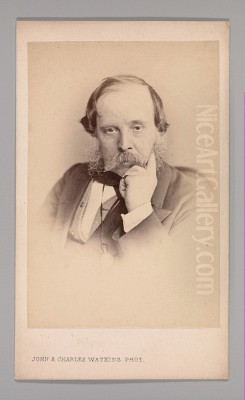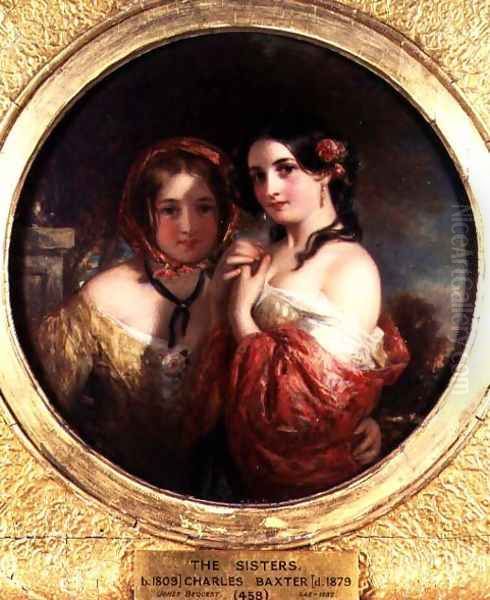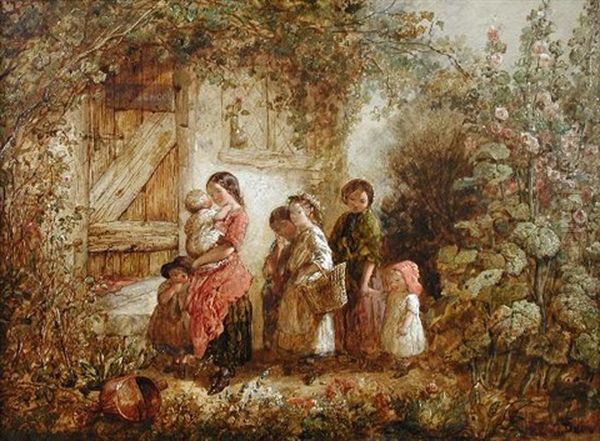
Charles Baxter (1809-1879) stands as a notable figure within the bustling art world of Victorian England. Primarily celebrated for his delicate and charming depictions of female beauty, Baxter carved a distinct niche for himself, producing works that resonated strongly with the tastes and sentiments of his era. Though perhaps overshadowed in modern times by the more revolutionary artists of his generation, Baxter's refined technique and appealing subject matter earned him considerable recognition and popularity during his lifetime. His art offers a fascinating window into the aesthetic preferences of the mid-19th century, particularly the era's fondness for idealized femininity, rustic charm, and sentimental narratives.
Early Life and Artistic Formation
Born in the heart of London in 1809, Charles Baxter's entry into the world of art was not immediate. His initial path led him towards a different craft altogether – bookbinding. This early training, demanding precision and attention to detail, may have subtly influenced the meticulous finish often seen in his later paintings. However, the allure of the visual arts proved stronger, and Baxter soon shifted his focus towards painting, seeking formal instruction to hone his burgeoning talent.
His crucial formative period was spent under the tutelage of George Clint (1770–1854). Clint, an Associate of the Royal Academy (ARA), was a respected artist known for his portraiture and, notably, his engaging theatrical conversation pieces, capturing actors in character. Studying with an established figure like Clint provided Baxter with essential technical skills, particularly in the demanding genre of portrait painting, and offered valuable insights into the workings of the London art establishment. Clint's own connection to the Royal Academy likely smoothed the path for his pupil's future exhibition career. Baxter initially also worked on miniatures, a field requiring exquisite detail and control, before concentrating on oil painting.
Ascendancy in the London Art World

Baxter's dedication and training soon bore fruit. The year 1834 marked a significant milestone as he exhibited his work for the first time at the prestigious Royal Academy of Arts in London. This debut placed him on a prominent stage, exposing his art to critics, patrons, and fellow artists. From this point forward, Baxter became a regular contributor to the RA's annual exhibitions, showcasing his paintings there consistently until 1872. This long exhibiting history demonstrates his sustained productivity and acceptance within the mainstream art institution of the time.
Further consolidating his professional standing, Baxter was elected a member of the Society of British Artists (SBA) in 1842. The SBA (which later gained a Royal charter) offered another important venue for artists to exhibit and sell their work, often appealing to those seeking alternatives or additions to the Royal Academy. Membership signified peer recognition and provided Baxter with a broader platform. Through consistent exhibition and the growing appeal of his chosen subjects, Baxter built a solid reputation as a skilled and popular painter.
Artistic Style: Delicacy, Charm, and Idealization
Charles Baxter's artistic identity is inextricably linked to his particular style and preferred subject matter. He became best known for his idealized portraits, predominantly featuring young women and children. These were often not commissioned likenesses in the traditional sense but rather "fancy pictures" – charming character studies or genre scenes designed to appeal to popular taste. His subjects were frequently depicted in rustic settings, as peasant girls, or adorned in slightly theatrical or historical costume, adding an element of gentle narrative or picturesque fantasy.
Stylistically, Baxter's work is characterized by its delicate colouring and smooth, refined finish. He possessed a notable skill in rendering soft flesh tones, lustrous hair, and the textures of fabrics. His palette tended towards warm, harmonious colours, enhancing the gentle and pleasing overall effect of his compositions. There is often a palpable sweetness and innocence in his figures, sometimes bordering on the sentimental – a quality highly valued by many Victorian viewers. His handling of light is typically soft and diffused, avoiding harsh contrasts and contributing to the idealized, almost dreamlike atmosphere of many works.
Critics and art historians have sometimes compared Baxter's treatment of youthful female subjects to the work of the 18th-century French painter Jean-Baptiste Greuze, who was renowned for his moralizing genre scenes and sentimental depictions of young women. While Baxter lacked Greuze's overt moralizing intent, the comparison highlights a shared focus on idealized innocence and feminine charm rendered with a smooth, appealing technique. Baxter's approach stood in contrast to the burgeoning realism or the more complex allegorical and historical narratives pursued by some of his contemporaries.
Representative Works

While Baxter was a prolific artist, certain works stand out as particularly representative of his style and popular appeal. Among his well-regarded paintings are:
The Sisters: This work likely exemplifies his skill in portraying youthful beauty and familial affection, a common theme in Victorian art. Such paintings often emphasized domestic harmony and idealized relationships.
Olivia and Sophia: Referencing characters from Oliver Goldsmith's popular novel The Vicar of Wakefield, this painting taps into the Victorian fondness for literary subjects. It allowed Baxter to depict charming female figures within a recognizable narrative context, appealing to a culturally literate audience.
Peasant Girl of Chioggia: This title suggests a picturesque or rustic genre scene, possibly inspired by travels or popular imagery of Italian life. It reflects the Victorian interest in romanticized depictions of rural folk and foreign lands, showcasing idealized beauty in a humble setting.
Love's Offering: The title itself evokes sentiment and romance, themes central to much of Baxter's output. Works like this often featured beautiful young women in thoughtful or tender poses, perhaps holding flowers or other symbolic objects, designed to evoke gentle emotions in the viewer.
Little Red Riding Hood: Depicting familiar fairy tales was another popular avenue for Victorian artists. This subject allowed Baxter to portray childhood innocence and vulnerability, themes that resonated strongly with the era's sensibilities.
These works, and others like them, cemented Baxter's reputation for creating visually pleasing, technically accomplished paintings that catered perfectly to the prevailing tastes for beauty, sentiment, and gentle narrative.
Baxter in the Context of Victorian Art
To fully appreciate Charles Baxter's career, it is essential to place him within the dynamic and diverse landscape of Victorian art. The mid-19th century was a period of significant artistic activity and stylistic evolution in Britain. The Royal Academy of Arts remained the dominant institution, setting standards and hosting the most important annual exhibition, but other organizations like the Society of British Artists also played vital roles.
Baxter worked alongside some of the giants of Victorian art. His contemporaries included artists pursuing vastly different paths. Sir Edwin Landseer, for instance, achieved immense fame with his dramatic animal paintings, often imbued with human-like emotions. Daniel Maclise and William Powell Frith excelled in large-scale historical and contemporary genre scenes, respectively, capturing the complexities of modern life or dramatic moments from the past, such as Frith's famous Derby Day.
The Pre-Raphaelite Brotherhood, founded in 1848, offered a radical challenge to Academic conventions. Artists like John Everett Millais, Dante Gabriel Rossetti, and William Holman Hunt advocated for a return to the perceived purity and detail of early Renaissance art, initially focusing on religious and literary themes with intense colour and meticulous realism. While Millais later became a highly successful society portraitist, and Rossetti developed a distinctive style focused on sensual female figures, their early work represented a significant departure from the smoother, more idealized aesthetic favoured by Baxter.
Other prominent figures included Sir Francis Grant, a leading society portraitist who eventually became President of the Royal Academy, and George Frederic Watts, known for his grand allegorical paintings and insightful portraits of eminent Victorians ("Hall of Fame"). Later in Baxter's career, artists like Frederick Leighton and Lawrence Alma-Tadema rose to prominence, specializing in meticulously rendered scenes from classical antiquity, reflecting a different facet of Victorian taste. James Sant, Painter in Ordinary to Queen Victoria, was another contemporary known for his graceful portraits, particularly of women and children, sharing some thematic ground with Baxter.
Compared to these diverse trends, Baxter's art occupied a specific, popular niche. He did not engage deeply with the social commentary seen in some genre painting, the intense symbolism of the Pre-Raphaelites, or the grand historical narratives favoured by others. Instead, he focused consistently on producing charming, aesthetically pleasing images that celebrated idealized beauty and gentle sentiment. His work perfectly aligned with a significant segment of Victorian taste that valued refinement, sweetness, and uncomplicated visual appeal, drawing perhaps on lingering influences from earlier masters of portraiture like Sir Thomas Lawrence or even the foundational figures of British portraiture, Thomas Gainsborough and Sir Joshua Reynolds, in its emphasis on grace and pleasing composition.
Later Life and Legacy
Charles Baxter continued to paint and exhibit throughout the middle decades of the 19th century, maintaining his presence in the London art scene. He passed away in Lewisham, then a suburb of London, in 1879, concluding a long and productive career dedicated to his particular vision of art.
In terms of legacy, Charles Baxter remains a representative figure of mid-Victorian artistic taste. While his work may not have broken new ground in the manner of the Pre-Raphaelites or later innovators, he achieved considerable success by skillfully catering to the aesthetic preferences of his time. His paintings were widely admired for their technical polish, delicate beauty, and sentimental charm. They found favour with middle-class patrons and were likely reproduced as prints, further disseminating his popular imagery.
Today, Baxter's paintings are held in various public collections, including the Victoria and Albert Museum in London and numerous regional galleries throughout the United Kingdom. While perhaps not a household name in the same league as Landseer, Millais, or Rossetti, his work continues to attract interest from collectors and enthusiasts of Victorian art. He is remembered as a master of a particular type of idealized female portraiture, an artist who captured a specific sensibility of his era with considerable grace and technical finesse. His paintings offer enduring examples of Victorian charm and the period's complex relationship with notions of beauty, innocence, and sentiment.
Conclusion
Charles Baxter was a significant and successful painter within the context of 19th-century British art. From his early training under George Clint to his long exhibiting career at the Royal Academy and the Society of British Artists, he established himself as a skilled practitioner, particularly admired for his idealized depictions of women and children. His style, characterized by delicate colouring, a smooth finish, and an emphasis on charm and sentiment, resonated deeply with Victorian audiences. While working during a time of great artistic diversity and innovation, alongside figures ranging from the Pre-Raphaelites to masters of grand narrative and classical scenes, Baxter cultivated a popular niche with his "fancy pictures." His representative works, often featuring literary heroines, picturesque peasant girls, or themes of love and innocence, remain testaments to his technical ability and his attunement to the tastes of his time. Charles Baxter's art provides a valuable insight into the Victorian era's aesthetic values and endures as an example of refined, charming, and skillfully executed portrait and genre painting.